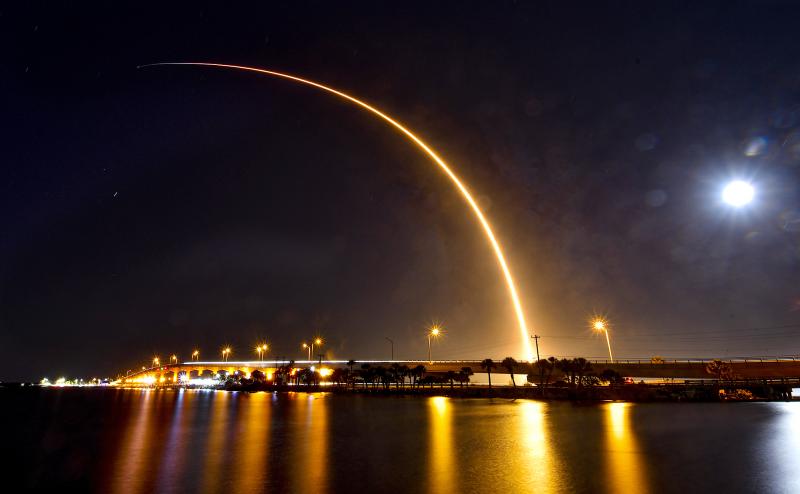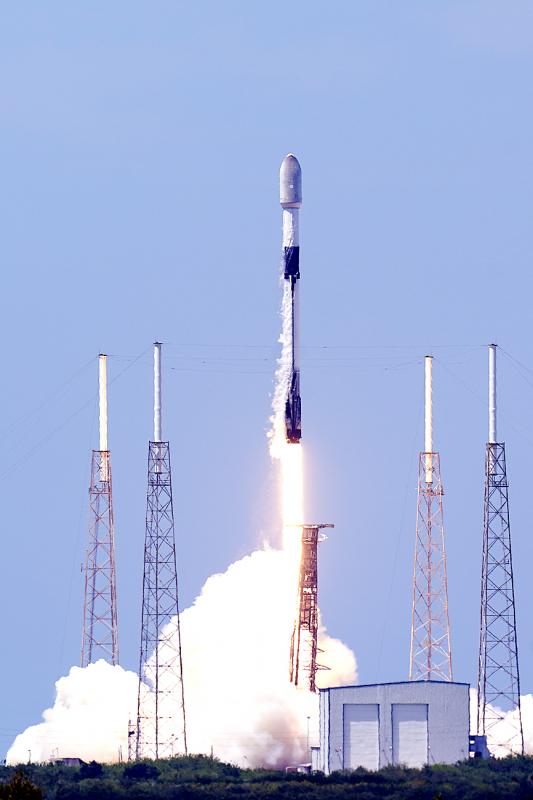Don Joyce, a Nokia Corp manager working from home at a remote lake cottage in Canada, recently abandoned his painfully slow phone-line Internet in favor of satellite broadband service Starlink, offered by Elon Musk’s Space Exploration Technologies Corp (SpaceX).
Starlink, which cost him C$600 (US$487) for hardware and a lofty C$150 monthly subscription, provides “blindingly fast” speeds when uploading videos or streaming movies, he said.
However, the beta test customer said he experiences dropouts during calls on Microsoft Teams and Zoom.

Photo: AP
“If you’re in the city and you have alternatives, I wouldn’t recommend it, but if you’re in the country, like in the middle of nowhere and you’re getting pathetic Internet service, then it’s definitely a competitor,” Joyce said.
For billionaire entrepreneur Elon Musk — CEO of electric vehicle manufacturer Tesla Inc — the success of one of his biggest bets could come down to just how many people like Joyce are out there.
Speaking at the Mobile World Congress event, Musk on Tuesday discussed progress in Starlink technology and subscriber growth as he forecast total investment costs in the satellite Internet business at as much as US$30 billion.

Photo: AP
If the service is successful, it could vastly expand the reach of broadband Internet around the world, connect Tesla vehicles, and even provide a new platform for traders and others with exotic Internet needs, people familiar with the Starlink plan said.
Yet to do that, it must avoid the fate of similar satellite ventures that have preceded it.
“Not bankrupt, that would be a big step,” Musk said last year. “That’s our goal.”
SpaceX’s Starlink division launched its “Better Than Nothing Beta program” in the US in October last year, with data speeds up to a competitive 150 megabits per second.
Early reviews are mixed, with some users complaining of the problems that have always plagued satellite Internet: sensitivity to weather.
Recent heat waves have caused new problems.
“I’m gonna have to spray it with a garden hose to reboot my Internet... That just feels so wrong,” a Reddit user who said he lives in Arizona posted earlier this month, along with an error message saying “Offline: Thermal shutdown” and “Starlink will reconnect after cooling down.”
SpaceX president Gwynne Shotwell in April said that the firm has “a lot of work to do to make the network reliable.”
Service should improve with more satellites and other improvements: Starlink has launched more than 1,700 of its 260kg satellites so far, and envisions more than 40,000.
The economics are daunting nonetheless.
Musk has said that Starlink could serve less than 5 percent of Internet users and still generate US$30 billion a year in revenue.
Critics have said that is wishful thinking.
“Is the demand there for tens of millions of subscribers at that price point?” asked analyst Tim Farrar, president at TMF Associates. “In most parts of the world, if you said to someone, your broadband service will cost you 100 US dollars a month, they’d be like, incredulous.”
He said there might be wealthy people in isolated areas, “but there’s just not very many of those people.”
Starlink would also struggle for enough capacity to support that level of demand, especially as people are consuming more data for video streaming, Farrar said.
That would mean “significant additional expenditure on upgrading the satellites and adding more satellites,” he added.
Pricing pain could be eased by nearly US$900 million in US Federal Communications Commission subsidies earmarked for Starlink for bringing the Internet to rural areas.
SpaceX vice president Jonathan Hofeller said COVID-19 highlighted the need for “access to quality Internet” anywhere on the globe.
Perhaps more importantly, Starlink said it can drive costs down by building its own terminals and satellites.
It has hired engineers from chipmakers Broadcom Inc, Qualcomm Inc and others to design its own communications chips, a person familiar with the matter said — an approach similar to that taken by Tesla.
Starlink has more than halved the terminal cost from US$3,000 and expects it to be in a range of a few hundred dollars within the next year or two, Shotwell said in April.
“Lowering Starlink terminal cost, which may sound rather pedestrian, is actually our most difficult technical challenge,” Musk wrote on Twitter last year.
Starlink also benefits from SpaceX’s low-cost launch capability.
“When you own pieces of the stack, you can do really technically sophisticated things at an affordable cost,” said Misha Leybovich, a former Starlink sales director.
Still, competition promises to be fierce. Amazon.com Inc subsidiary Kuiper Systems LLC has a directly competing project, while OneWeb — a collapsed satellite operator rescued by the British government and India’s Bharti Group — has vowed to be in the game as well.
OneWeb said on Tuesday that it has secured an additional US$500 million investment from Bharti, bringing its total funding to US$2.4 billion.
Meanwhile, terrestrial telecom providers are racing to deploy high-speed 5G broadband services.
The rapid spread of wireless and terrestrial broadband, along with high prices, were significant factors in killing previous low-Earth-orbit satellite ventures. Iridium Communications Inc, which was backed by Motorola Inc, went through bankruptcy after billions of dollars in investment, while a similar fate met Teldesic, backed by Microsoft Corp founder Bill Gates.
SpaceX, Amazon and a number of others have “created quite a race that no one is absolutely sure whether there is a big enough market for it,” Iridium chief executive officer Matthew Desch said.

Taiwan’s rapidly aging population is fueling a sharp increase in homes occupied solely by elderly people, a trend that is reshaping the nation’s housing market and social fabric, real-estate brokers said yesterday. About 850,000 residences were occupied by elderly people in the first quarter, including 655,000 that housed only one resident, the Ministry of the Interior said. The figures have nearly doubled from a decade earlier, Great Home Realty Co (大家房屋) said, as people aged 65 and older now make up 20.8 percent of the population. “The so-called silver tsunami represents more than just a demographic shift — it could fundamentally redefine the

The US government on Wednesday sanctioned more than two dozen companies in China, Turkey and the United Arab Emirates, including offshoots of a US chip firm, accusing the businesses of providing illicit support to Iran’s military or proxies. The US Department of Commerce included two subsidiaries of US-based chip distributor Arrow Electronics Inc (艾睿電子) on its so-called entity list published on the federal register for facilitating purchases by Iran’s proxies of US tech. Arrow spokesman John Hourigan said that the subsidiaries have been operating in full compliance with US export control regulations and his company is discussing with the US Bureau of

Businesses across the global semiconductor supply chain are bracing themselves for disruptions from an escalating trade war, after China imposed curbs on rare earth mineral exports and the US responded with additional tariffs and restrictions on software sales to the Asian nation. China’s restrictions, the most targeted move yet to limit supplies of rare earth materials, represent the first major attempt by Beijing to exercise long-arm jurisdiction over foreign companies to target the semiconductor industry, threatening to stall the chips powering the artificial intelligence (AI) boom. They prompted US President Donald Trump on Friday to announce that he would impose an additional

Pegatron Corp (和碩), a key assembler of Apple Inc’s iPhones, on Thursday reported a 12.3 percent year-on-year decline in revenue for last quarter to NT$257.86 billion (US$8.44 billion), but it expects revenue to improve in the second half on traditional holiday demand. The fourth quarter is usually the peak season for its communications products, a company official said on condition of anonymity. As Apple released its new iPhone 17 series early last month, sales in the communications segment rose sequentially last month, the official said. Shipments to Apple have been stable and in line with earlier expectations, they said. Pegatron shipped 2.4 million notebook